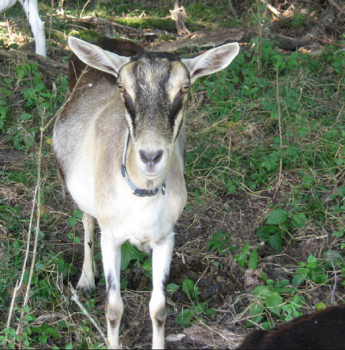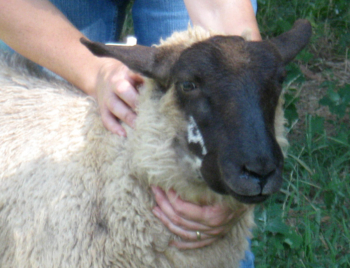Tips for Marketing Sheep and Goat Products: Live Animals

Photo: NCAT
NCAT Marketing Tipsheet Series
By Margo Hale and Linda Coffey, NCAT
There are many options for marketing sheep and goats. You will have to explore what market options are available in your area and decide what marketing method, or combination of methods, will work best for your farm and farm goals. This tip sheet will explain some of the common market options, address advantages and considerations for each marketing option, and provide further resources.
Market Options |
Advantages |
Considerations |
| Sale Barn/Livestock Auction | ||
| This is the traditional livestock marketing venue. | Requires very little effort—you drop your animals off at the sale and receive your check the next week. A marketing option if you don’t want to deal directly with customers. A place to sell unproductive or unwanted animals. | You never know the price you will receive for your animals. Your animals may not bring what you think they are worth. You will be charged fees—commission, yardage, tagging fees. This reduces the amount of money you bring home. |
| On-Farm Sale | ||
| You can sell animals directly from your farm. These can be animals sold for meat or for breeding or show stock. | You set the price. You don’t have any fees to pay and you don’t have the cost of hauling your animals to a sale. If you have a consistent quality of animals, then you can develop a base of repeat customers. | Can be very time-consuming. You have to arrange times for buyers to come to your farm, and you may have buyers come when you haven’t arranged a time. You may only be selling one animal at a time. If you are selling breeding stock or show stock, you must only sell high-quality animals for these purposes. It may take some time and marketing effort to establish yourself as a quality breeder. |
On-Farm Slaughter
You may have customers interested in slaughtering animals on your farm, usually for religious reasons. If you allow on-farm slaughter, it can be a great service you provide to your customers. On-farm slaughter falls under an exemption to the Federal Meat Inspection Act. States can’t disallow on-farm slaughter, but state and local regulations can impose additional requirements. You must check your local regulations before allowing on-farm slaughter.
Market Options |
Advantages |
Considerations |
| Pooled Sale | ||
| A pooled sale is where you cooperate with other producers to sell a very large group of uniform animals to a buyer. | Price is generally set ahead of time, so you know what you will be getting for your animals. A way to market a large group of animals at once, with less risk than a sale barn because you know the price you will receive. | Requires cooperation with other producers and a buyer. You must meet the buyer’s requirements. The buyer will usually set a target weight of the animal and the number of animals he wants to buy. You may have to pay some fees—commission, trucking. Pooled sales are not available in all areas. You may work with your local producer’s group to organize such a sale. |
| Graded Sale | ||
| A graded sale is like a pooled sale in that a buyer is looking to buy a large lot of uniform animals. There will be a USDA grader present to evaluate the animals. Prices will depend on the quality (#1, #2, #3) of the animal. | Price is set ahead of time, so you know what each grade will bring. You will be paid for quality. Heavily muscled animals will bring more per pound. A way to market a large group of animals at once, with less risk than a sale barn because you know the price you will receive. | You may have to pay some fees— commission, tag fees, etc. Graded sales are not available in all areas. You will have to work with other producers, a buyer, and a USDA grader to organize this type of sale. |
USDA Selection Grades

Photo: NCAT
USDA Selection Grades are based on the meat type conformation of the goat (how thickly muscled it is).
- Selection #1—Goats should have a pronounced bulging to the outside hind leg, a full, rounded backstrip and a moderately thick outside shoulder.
- Selection #2—Goats have moderate meat conformation.
- Selection #3—Goats have an inferior conformation.
Resources
ATTRA – National Sustainable Agriculture Information Service
Maryland Small Ruminant Page—Marketing
Cornell University—Sheep & Goat Marketing
Marketing Meat Goats, the Basic System—Kentucky State University Cooperative Extension Program
Tips for Marketing Sheep and Goats: Live Animals
© 2012 National Center for Appropriate Technology—NCAT
By Margo Hale and Linda Coffey, NCAT
IP398
This publication is produced by the National Center for Appropriate Technology through the ATTRA Sustainable Agriculture program, under a cooperative agreement with USDA Rural Development. This publication was also made possible in part by funding from USDA/NIFA/OASDFR. ATTRA.NCAT.ORG.
Related Publications
- Tips for Marketing Sheep and Goat Products: Vegetation Management
- Sheep and Goats: Frequently Asked Questions
- Meat Goats: Sustainable Production
- Tips for Marketing Sheep and Goat Products: Meat
- Tipsheet: Organic Cattle, Sheep, and Goats for Dairy
- Tips for Marketing Sheep and Goat Products: Dairy
- Dairy Production on Pasture: An Introduction to Grass-Based and Seasonal Dairying


